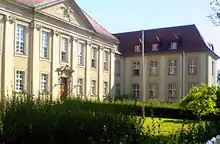Dahlem (Berlin)
Dahlem (German: [ˈdaːlɛm] (![]() listen) or [ˈdaːləm]) is a locality of the Steglitz-Zehlendorf borough in southwestern Berlin. Until Berlin's 2001 administrative reform it was a part of the former borough of Zehlendorf.
listen) or [ˈdaːləm]) is a locality of the Steglitz-Zehlendorf borough in southwestern Berlin. Until Berlin's 2001 administrative reform it was a part of the former borough of Zehlendorf.
Dahlem | |
|---|---|
Quarter of Berlin | |
 "Rost- and Silberlaube" complex of the FU Berlin | |
Location of Dahlem in Steglitz-Zehlendorf and Berlin  | |
 Dahlem  Dahlem | |
| Coordinates: 52°27′29″N 13°17′15″E | |
| Country | Germany |
| State | Berlin |
| City | Berlin |
| Borough | Steglitz-Zehlendorf |
| Founded | 1275 |
| Area | |
| • Total | 8.39 km2 (3.24 sq mi) |
| Elevation | 50 m (160 ft) |
| Population (June 30, 2013) | |
| • Total | 15,796 |
| • Density | 1,900/km2 (4,900/sq mi) |
| Time zone | UTC+01:00 (CET) |
| • Summer (DST) | UTC+02:00 (CEST) |
| Postal codes | (nr. 0605) 12203, 14169, 14195 |
| Vehicle registration | B |
Dahlem is one of the most affluent parts of the city and a center for academic research. It is home to the Freie Universität Berlin, with its Philological Library ("The Brain") by Norman Foster as a landmark. Several other research institutions; the Jesus-Christus-Kirche, where most of the legendary Berlin Philharmonic recordings were made from the 1950s through the 1980s owing to its fine acoustics; the Berlin Botanical Garden, although officially on the ground of neighbouring Lichterfelde; parts of the Grunewald forest, including its Renaissance hunting lodge built in 1543; and many museums — all are there.
Although Dahlem has a reputation as an idyllic and quiet area, it is busy with students arriving by U-Bahn on weekdays.
History
The first written account of Dahlem dates to the year 1275. The history of the village is connected to the Dahlem Demesne (Domäne Dahlem) first mentioned in 1450. Its estates were sold to the state of Prussia in 1841 and developed by dividing it into lots for building villas and mansions. The Demesne buildings today house a working farm and an agricultural open-air museum. In 1920 the village was amalgamated into Greater Berlin. From 1931 on Martin Niemöller, a leader of the Confessing Church, was pastor of the United Protestant Sankt-Annen-Kirche until he was arrested by the Nazis in 1937.
During the Cold War Dahlem belonged to the American Sector of West Berlin. From 1945 to 1991 the seat of the Allied Kommandatura of Berlin was in Dahlem on Kaiserswerther Straße. Today it serves as the office for the president of the local university. Until 1994, the headquarters of the United States Army Berlin command and the Berlin Brigade were located on Clayallee street. Parts of the building are still used by the Embassy of the United States in Berlin. The former library and Outpost theater across the street today house the Allied Museum. Because many of Berlin's artistic, cultural, and educational institutions were located in the city's historical center in the former eastern part of Berlin, West Berlin authorities established many duplicates in Dahlem - above all the Freie Universität Berlin (literally the "Free University Berlin") in 1948, which was established by students and scholars as an antipole to the increasingly communist "Universität Unter den Linden". The newly founded university should uphold the traditional values of academic freedom and the educational ideal proposed by Wilhelm von Humboldt.
Rudi Dutschke, spokesman of the German student movement in the 1960s, is buried at the cemetery of the Sankt-Annen-Kirche.
Institutions
- Freie Universität Berlin (Free University of Berlin, known as FU Berlin)
- Julius Kühn-Institut (Federal Research Centre for Cultivated Plants)
- Prussian Privy State Archives of the Prussian Cultural Heritage Foundation
- Federal Institute for Materials Research and Testing
- German Archaeological Institute
- German Institute for Economic Research
- Institute for Museum Research
- Zuse Institute Berlin
- Several branches of the Max Planck Institute (former Kaiser Wilhelm Institute):
- The Max Planck Institute Archives
- The Fritz Haber Institute
- The Max Planck Institute for Human Development
- The Max Planck Institute for Molecular Genetics
- The Max Planck Institute for the History of Science
Main sights
- Museums
- The Allied Museum of the American, British and French forces in West Berlin
- The Brücke Museum
- The Museum Center of the Berlin State Museums, which includes:
- Dahlem Manor
Transportation
Dahlem is served by the U3 line on the Berlin U-Bahn system. As in the neighboring Wilmersdorf, the historic metro stations are a special feature of the district. Stations in Dahlem include Breitenbachplatz, Podbielskiallee, Dahlem-Dorf, Thielplatz and Oskar-Helene-Heim.

 Podbielskiallee station
Podbielskiallee station

_-_geo.hlipp.de_-_35968.jpg.webp)
_1129-1009-(120).jpg.webp)
